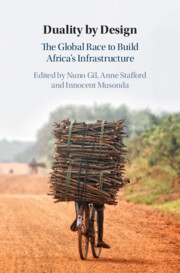Book contents
- Reviews
- Duality by Design
- Duality by Design
- Copyright page
- Contents
- Figures
- Tables
- Contributors
- Foreword
- Acknowledgements
- 1 Duality by Design: The Global Race to Build Africa’s Infrastructure
- Part I Mitigating Institutional Voids by Design
- 2 Why the Lights Went Out: A Capability Perspective on the Unintended Consequences of Sector Reform Processes
- 3 When the Quest for Electricity Reform and the Need for Investment Collide: South Africa, 1998–2004
- 4 Institutional Enablers of Energy System Transition: Lessons from Solar Photovoltaic Electricity in Eight African Countries
- 5 Harnessing Africa’s Energy Resources through Regional Infrastructure Projects
- 6 Centralized vs. Decentralized Generation in Zambia: Meeting Electricity Demand in the Context of Climate Change
- 7 Delivering Healthcare Infrastructure and Services through Public–Private Partnerships: The Lesotho Case
- 8 Achieving Long-Term Financial Sustainability in African Infrastructure Projects
- 9 A Proactive Social Infrastructure Model for Future Mixed-Use Housing in Egypt
- 10 Collective Action under the Shadow of Contractual Governance: The Case of a Participatory Approach to Upgrade Cairo’s ‘Garbage Cities’
- Part II Exploiting Institutional Voids by Design
- Afterword
- Index
- References
6 - Centralized vs. Decentralized Generation in Zambia: Meeting Electricity Demand in the Context of Climate Change
from Part I - Mitigating Institutional Voids by Design
Published online by Cambridge University Press: 14 November 2019
- Reviews
- Duality by Design
- Duality by Design
- Copyright page
- Contents
- Figures
- Tables
- Contributors
- Foreword
- Acknowledgements
- 1 Duality by Design: The Global Race to Build Africa’s Infrastructure
- Part I Mitigating Institutional Voids by Design
- 2 Why the Lights Went Out: A Capability Perspective on the Unintended Consequences of Sector Reform Processes
- 3 When the Quest for Electricity Reform and the Need for Investment Collide: South Africa, 1998–2004
- 4 Institutional Enablers of Energy System Transition: Lessons from Solar Photovoltaic Electricity in Eight African Countries
- 5 Harnessing Africa’s Energy Resources through Regional Infrastructure Projects
- 6 Centralized vs. Decentralized Generation in Zambia: Meeting Electricity Demand in the Context of Climate Change
- 7 Delivering Healthcare Infrastructure and Services through Public–Private Partnerships: The Lesotho Case
- 8 Achieving Long-Term Financial Sustainability in African Infrastructure Projects
- 9 A Proactive Social Infrastructure Model for Future Mixed-Use Housing in Egypt
- 10 Collective Action under the Shadow of Contractual Governance: The Case of a Participatory Approach to Upgrade Cairo’s ‘Garbage Cities’
- Part II Exploiting Institutional Voids by Design
- Afterword
- Index
- References
Summary
This chapter investigates the feasibility of large-scale centralized renewable generation and residential solar photovoltaic electricity (PV) in addressing Zambia’s electricity deficit, caused by droughts which are in turn attributable to climate disturbances and the nation’s rapidly increasing electricity demand. Specifically, it was found that centralized solar generation when optimally located could produce generation/cost ratios as low as $0.042/kWh, comparable with existing hydro generation cost ratios of $0.02-$0.03/kWh. For the decentralized generation scenarios, which analyzed the potential of on-grid and off-grid solar PV generation in Lusaka, Zambia’s capital, it was observed that a fully decentralized approach is not economically feasible, as electricity would be 6 to 12 times as costly as the existing rate. A series of hybrid scenarios, with varying combinations of centralized and decentralized generation, were also analyzed, with the 70 percent centralized, 30 percent decentralized scenario being found to best address Zambia’s electricity shortage. This approach would both provide affordable power and enable quicker implementation, greater consumer autonomy, easier planning, and diversified sources of funding. It would also enhance Zambia’s ability to become a continental leader in renewable energy.
- Type
- Chapter
- Information
- Duality by DesignThe Global Race to Build Africa's Infrastructure, pp. 161 - 202Publisher: Cambridge University PressPrint publication year: 2019

